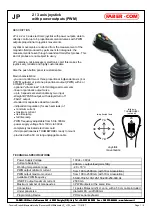
DocID018909 Rev 11
RM0090
USB on-the-go high-speed (OTG_HS)
1529
during USB operations. Any unforeseen V
BUS
voltage drop below the V
BUS
valid threshold
(4.25 V) generates an OTG interrupt triggered by the session end detected bit (SEDET bit in
OTG_HS_GOTGINT). The application must then switch the V
BUS
power off and clear the
port power bit.
When HNP and SRP are both disabled, the VBUS sensing pin (PB13) should not be
connected to V
BUS
. This pin can be can be used as GPIO.
The charge pump overcurrent flag can also be used to prevent electrical damage. Connect
the overcurrent flag output from the charge pump to any GPIO input, and configure it to
generate a port interrupt on the active level. The overcurrent ISR must promptly disable the
V
BUS
generation and clear the port power bit.
Detection of peripheral connection by the host
If SRP or HNP are enabled, even if USB peripherals or B-devices can be attached at any
time, the OTG_HS does not detect a bus connection until the end of the V
BUS
sensing
(V
BUS
over 4.75 V).
When V
BUS
is at a valid level and a remote B-device is attached, the OTG_HS core issues a
host port interrupt triggered by the device connected bit in the host port control and status
register (PCDET bit in OTG_HS_HPRT).
When HNP and SRP are both disabled
, USB peripherals or B-device are detected as
soon as they are connected.
The OTG_FS core issues a host port interrupt triggered by
the device connected bit in the host port control and status (PCDET bit in OTG_FS_HPRT).
Detection of peripheral disconnection by the host
The peripheral disconnection event triggers the disconnect detected interrupt (DISCINT bit
in OTG_HS_GINTSTS).
Host enumeration
After detecting a peripheral connection, the host must start the enumeration process by
issuing an USB reset and configuration commands to the new peripheral.
Before sending an USB reset, the application waits for the OTG interrupt triggered by the
debounce done bit (DBCDNE bit in OTG_HS_GOTGINT), which indicates that the bus is
stable again after the electrical debounce caused by the attachment of a pull-up resistor on
OTG_HS_FS_DP (full speed) or OTG_HS_FS_DM (low speed).
The application issues an USB reset (single-ended zero) via the USB by keeping the port
reset bit set in the Host port control and status register (PRST bit in OTG_HS_HPRT) for a
minimum of 10 ms and a maximum of 20 ms. The application monitors the time and then
clears the port reset bit.
Once the USB reset sequence has completed, the host port interrupt is triggered by the port
enable/disable change bit (PENCHNG bit in OTG_HS_HPRT) to inform the application that
the speed of the enumerated peripheral can be read from the port speed field in the host
port control and status register (PSPD bit in OTG_HS_HPRT), and that the host is starting
to drive SOFs (full speed) or keep-alive tokens (low speed). The host is then ready to
complete the peripheral enumeration by sending peripheral configuration commands.
















































